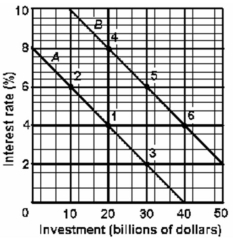Multiple Choice

-Lines A and B in the above graph represent:
A) the crowding-out effect.
B) the interest-rate effect.
C) investment demand curves.
D) money demand curves.
Correct Answer:

Verified
Correct Answer:
Verified
Related Questions
Q36: The federal budget deficit is found by<br>A)subtracting
Q39: An expansionary fiscal policy is shown as
Q44: In Year 1, the actual budget deficit
Q79: If the economy has a cyclically adjusted
Q83: The crowding-out of investment may be avoided
Q92: The crowding-out effect arises when:<br>A)government borrows in
Q125: In an economy, the government wants to
Q128: The table below shows the full-employment budget
Q129: Refer to the diagram below.Which tax system
Q153: A contractionary fiscal policy in Canada which